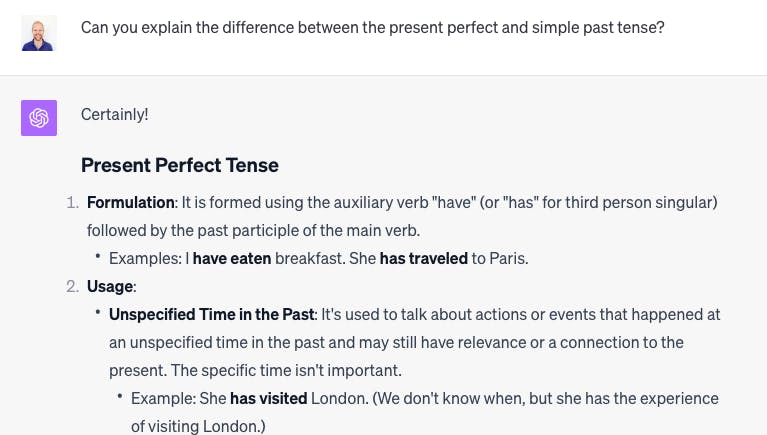How TEFL Teachers Can Use ChatGPT & AI (to Do an Even Better Job)

The digital revolution has ushered in a plethora of technologies, with artificial intelligence (AI) emerging as the crown jewel. From simplifying complex tasks to enhancing user experiences, AI has permeated nearly every facet of our lives. The education sector is no exception. As TEFL (Teaching English as a Foreign Language) educators, the potential of tools like ChatGPT offers a unique opportunity to elevate the teaching and learning experience. So, what's all the buzz about ChatGPT, and why should TEFL teachers be excited?
What is ChatGPT and How Does It Work?
ChatGPT, developed by OpenAI, stands out in the crowded AI landscape due to its proficiency in natural language processing. At its core, ChatGPT is designed to understand and generate text that's eerily similar to human conversation. But it's not just about simulating human-like chats; it's about understanding context, nuance, and the intricacies of language.
Benefits of Integrating ChatGPT in TEFL
Instant Feedback: The learning curve for mastering a new language can be steep. One of the challenges students face is the wait time for feedback. With ChatGPT, that's a concern of the past. Students can pose language queries, test out sentence structures, or clarify doubts and receive immediate responses. This real-time feedback accelerates the learning process, allowing students to rectify mistakes on the fly.
Homework Assistance: Remember those evenings spent grappling with tricky English assignments? ChatGPT can be a savior for students, assisting with vocabulary choices, grammar checks, and even offering suggestions for sentence improvement. It's like having a patient English tutor available round the clock.
Conversation Practice: One of the best ways to learn a language is to speak it. But not all students have the luxury of an English-speaking environment. Here's where ChatGPT shines. Students can engage in conversations with the AI, practicing fluency, pronunciation, and gaining confidence in their speaking skills. It's a judgment-free zone where learners can converse, make mistakes, learn, and grow.
Creative Ways TEFL Teachers Can Use ChatGPT & AI:
1. Providing Grammar Explanations
While search engines are great for quick facts, TEFL teachers can use ChatGPT for more nuanced language questions. Whether it's complex grammar structures or idiomatic expressions, ChatGPT offers detailed answers. Don't forget to cross-check information, especially for academic purposes.
Example:

2. Tailored Reading Passages
Struggling to find the right reading material for your English class? ChatGPT can craft passages based on topics relevant to your curriculum, adjusted to different English proficiency levels.
Example:

3. Interactive Review Questions
Beyond traditional homework, encourage students to generate their own English review questions using ChatGPT. They can challenge themselves and verify answers using the same tool!
Example:

4. Engaging Writing Prompts
Kickstart your students' creativity by letting ChatGPT introduce a story or scenario. Perfect for those days when you’re lacking inspiration!
Example:

5. Dynamic Vocabulary Lessons
Introduce new vocabulary through ChatGPT. Generate sentences showcasing word usage, and let students infer meanings using context.
Example:

6. Communicating with Parents
Do you have to communicate with parents about a student's progress or classroom events? Use ChatGPT to help craft clear, respectful messages to parents, especially if English isn't their first language.
Example:

7. Diverse Language Examples
Do you need examples of different tenses, voices, or modal verbs? TEFL teachers can use ChatGPT to generate varied sentences, making grammar lessons more engaging.
Example:

8. ESL Lesson Plan Inspiration
While nothing replaces a teacher's touch, ChatGPT can offer basic lesson plan ideas, especially for thematic units or cultural lessons. Use it as a starting point and infuse with your teaching style.
Example:

9. Support Strategies for ESL Difficulties
For students struggling with specific aspects of English, ChatGPT can suggest learning strategies or resources tailored to their needs.
Example:

10. Discussion/Essay Questions
From cultural differences to English idioms, TEFL teachers can use ChatGPT to generate fresh discussion or essay questions for each unit, ensuring your classroom discussions stay interesting.
Example:

11. Crafting Recommendation Letters
If you're recommending a student for an English proficiency program or scholarship, ChatGPT can help you start the letter, ensuring clarity and coherence.
Example:

12. Preparing for Sensitive Conversations
Discussing language barriers or cultural misunderstandings with students and parents can be delicate. Use ChatGPT to draft conversation starters or scripts.
Example:

13. Generating Vocabulary Resource Lists
Need a list of phrasal verbs, irregular verbs, or collocations? ChatGPT can quickly compile them for classroom activities.
Example:

14. Keeping Up with English Slang
Stay updated with current English slang terms to better relate to students and understand their informal conversations.
Example:

15. Debating Cultural Topics
Challenge students to "debate the bot" on cultural topics, helping them practice their debating skills in English.
Example:

16. Structuring ESL Essays
Allow students to use ChatGPT to create basic outlines for essays on English literature or cultural topics.
Example:

17. Correcting Mistakes and Enhancing Writing Skills
After students draft essays or paragraphs, use ChatGPT for suggestions. Discuss the proposed changes in class, enhancing their editing skills.
Example:

18. Practicing Peer Feedback
Using bot-generated English essays, students can practice providing constructive feedback, honing their analytical and language skills simultaneously.
Example:

19. Self-Assessment Tools
TEFL teachers can use ChatGPT to encourage students to test their English understanding by answering questions and then verifying their answers using ChatGPT, fostering independence in learning.
Example:

Potential Challenges and How to Overcome Them
Over-reliance on AI
The convenience of ChatGPT and similar tools can be enticing for both teachers and students. However, there's a risk of students becoming overly dependent on AI for answers, bypassing critical thinking.
Solution: Implement a balance. Use ChatGPT as a supplementary tool rather than the primary source of information. Encourage students to first attempt tasks independently and then cross-check or enhance their work using the AI.
Accuracy and Verification
While ChatGPT is impressive, it's not infallible. There might be instances where the information provided isn't entirely accurate or lacks context.
Solution: Always encourage students to verify information from trusted primary sources, especially for academic or examination purposes. This practice not only ensures accuracy but also instills a habit of critical evaluation.
Loss of Personal Touch
In the realm of language learning, personal interactions, cultural nuances, and human touchpoints are invaluable. Overusing AI might lead to sterile or generic interactions.
Solution: Blend traditional teaching methods with AI. For instance, after a ChatGPT-assisted conversation practice, have peer-to-peer conversations to infuse genuine cultural and emotional exchanges.
Technical Hurdles
Not all students might have equal access to advanced tech tools, or there might be technical glitches disrupting a smooth AI experience.
Solution: While integrating AI into lessons, always have backup plans. Offline activities, printed materials, or peer interactions can serve as effective alternatives.
The fusion of TEFL teaching with tools like ChatGPT promises a dynamic and enriched learning environment. It's not about replacing the invaluable human touch of a teacher but about enhancing it, making the educational journey more interactive, responsive, and tailored. As with all tools, the key lies in balanced and informed use. By understanding the potential and pitfalls of ChatGPT, TEFL educators can harness its power, offering students a holistic, modern, and engaging path to mastering the English language. So, TEFL teachers, it's time to embrace the future and let AI elevate your teaching skills!
Popular Posts
Gap year in Barcelona? Here's your pre-travel checklist for 2026

Gap year programs in Spain - 5 of the best for 2026

Living in Spain vs. Australia - what are the benefits?

Moving from San Francisco to Barcelona

Subscribe To Our Mailing List!
Receive course updates, graduate reviews, exclusive discounts and more



